R.J. Stowell's Blog: rjsomeone, page 24
June 8, 2020
Plastic Ono Band (AM9)Artist: John LennonProduced by...
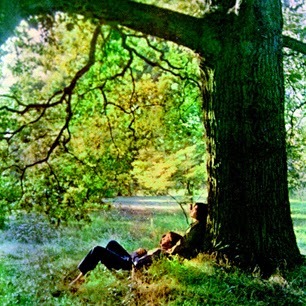 Plastic Ono Band
(AM9)Artist: John LennonProduced by: John Lennon, Yoko Ono and Phil SpectorReleased: December 11, 1970Length: 39:45Tracks: 1) Mother (5:34); 2) Hold On (1:52); 3) I Found Out (3:37) 4) Working Class Hero (3:48); 5) Isolation (2:51); 6) Remember (4:33) 7) Love (3:21); 8) Well, Well, Well (5:59); 9) Look At Me (2:53); 10) God (4:09); 11) My Mummy's Dead (:49)Players: John Lennon - vocals, guitar, piano, organ; Ringo Starr - drums, percussion; Klaus Voorman - bass; Phil Spector - piano, synths; Billy Preston – Piano ("God")
Plastic Ono Band
(AM9)Artist: John LennonProduced by: John Lennon, Yoko Ono and Phil SpectorReleased: December 11, 1970Length: 39:45Tracks: 1) Mother (5:34); 2) Hold On (1:52); 3) I Found Out (3:37) 4) Working Class Hero (3:48); 5) Isolation (2:51); 6) Remember (4:33) 7) Love (3:21); 8) Well, Well, Well (5:59); 9) Look At Me (2:53); 10) God (4:09); 11) My Mummy's Dead (:49)Players: John Lennon - vocals, guitar, piano, organ; Ringo Starr - drums, percussion; Klaus Voorman - bass; Phil Spector - piano, synths; Billy Preston – Piano ("God")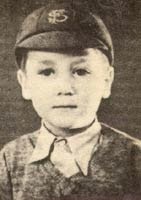
Poet, TS Eliot popularized the "objective correlative;" the idea that in order for a work to gain value moving forward, emotional content must be non-specific. Here, as an example, is a scene from a cheesy melodrama: Fade in - a cemetery filled with weather-worn headstones, droplets of rain cascading down stone angel faces; a small congregation of people dressed in black holding umbrellas. An old woman raises a veil, takes off a ring, places it on a coffin; faint sobbing is audible. Slowly the clouds break and a shaft of sunlight shines on a single blooming yellow marigold. Credits.
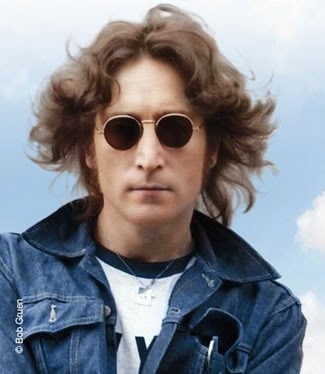 The viewer's emotional response, which starts off somber, ends with renewed hope for the old woman, though the filmmaker provides nothing tangible to conjure this analysis. Sunlight induces joy as readily as it causes skin cancer; a marigold by itself is pretty, but one doesn’t necessarily sense optimism in its presence. The emotional response originates, not in a word, image, action or reaction, but in the combination of all; a sort of emotional algebra. The objective correlative is the formula for creating a specific emotional reaction merely by the juxtaposed presence of common words, objects, or items. The sum is greater than the parts.
The viewer's emotional response, which starts off somber, ends with renewed hope for the old woman, though the filmmaker provides nothing tangible to conjure this analysis. Sunlight induces joy as readily as it causes skin cancer; a marigold by itself is pretty, but one doesn’t necessarily sense optimism in its presence. The emotional response originates, not in a word, image, action or reaction, but in the combination of all; a sort of emotional algebra. The objective correlative is the formula for creating a specific emotional reaction merely by the juxtaposed presence of common words, objects, or items. The sum is greater than the parts.  For our purposes in analyzing music, the theory maintains that the songwriter's itinerary cannot be so specific as to render the listener unable to respond without a back story. Though an appealing ideology (and one that AM is often guilty: reviewing music in a vacuum), dismissing what is topical ofttimes diminishes content. "For What It’s Worth" seems the perfect reflection of war protests, yet the song really addresses the teen riots on the Sunset Strip (see the post from February 21, 2015). The song’s impact, though, is not lessened based on this misinterpretation (reinforceing Eliot’s theory), yet that is not always the case.
For our purposes in analyzing music, the theory maintains that the songwriter's itinerary cannot be so specific as to render the listener unable to respond without a back story. Though an appealing ideology (and one that AM is often guilty: reviewing music in a vacuum), dismissing what is topical ofttimes diminishes content. "For What It’s Worth" seems the perfect reflection of war protests, yet the song really addresses the teen riots on the Sunset Strip (see the post from February 21, 2015). The song’s impact, though, is not lessened based on this misinterpretation (reinforceing Eliot’s theory), yet that is not always the case.John Lennon’s "God," is the antithesis of the theory. "God" is Lennon denouncing his past, his influences, his beliefs and associations. The song can have no impact sung by anyone but Lennon (as it was by Andrew McMahon on the Instant Karma: Save Darfur tribute album). Certainly comments about Yogi or Elvis or "Zimmerman" (Bob Dylan) can be interpolated by any singer, but lines like "I don’t believe in Beatles…I just believe in me (Yoko and me)," make the song valueless by any interpretation other than Lennon's.
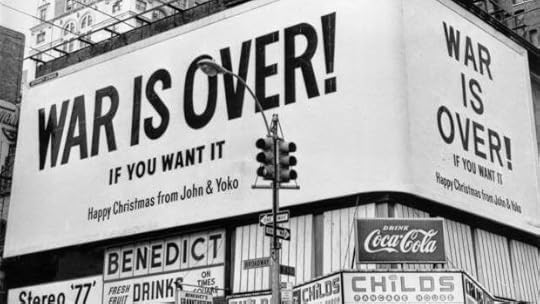
Plastic Ono Band is an album that personal. After the breakup of The Beatles, John released several singles ("Give Peace A Chance," "Cold Turkey," "Instant Karma!") and experimental (i.e. unlistenable) albums with Yoko Ono (Unfinished Music No.1: Two Virgins, Unfinished Music No.2: Life with the Lions, and Wedding Album) before delivering Plastic Ono Band, his first bold post-Beatles solo album. Using sparse rock 'n' roll as the backbone for baring his soul (and greatly influenced by the primal scream therapy of Dr. Arthur Janov), Lennon angrily denounces his past ("God"), looks back at his painful relationship with his parents ("Mother," "My Mummy’s Dead"), blasts hippie hangers-on looking for a handout ("I Found Out"), and professes his love for Yoko on several accounts as he searches for peace of mind and a spiritual sense of self. "Mother" is one of John's most affecting songs, particularly its anguished, oft-repeated last line ("Mother don’t go, daddy come home."). Another key track, the most familiar on the album, "Working Class Hero," features Lennon "unplugged" and some bitingly cynical social commentary.

Though the album is at times more impressive than enjoyable, Lennon’s brilliant vocal performance makes up for its shortcomings. The exceedingly spry instrumentation, centered on Lennon's guitar and piano work, Klaus Voorman's bass, and the backbeat of Ringo Starr, distances Lennon from the lush sonics of Abbey Road and his former identity ("I was the walrus, but now I'm John"). In direct contrast to his usual grandiose productions, Spector is smart and ego-less enough to let the songs' primitive strengths shine through.
If The Beatles' breakup and Altamont hadn’t signaled the end of the '60s, John singing "the dream is over" certainly did. The album's enduring reputation (despite being a commercial failure) is due to its incredible intensity and unflinching honesty. Though many of the songs are soft spoken, John would never again give such a visceral performance.
50 years ago, Lennon's Plastic Ono Band, which included Yoko, Billy Preston, Ringo and Klaus Voorman, with Phil Spector on bass, entered the studio to record what Rolling Stone calls the 23 best LP of all time.
Published on June 08, 2020 07:15
June 6, 2020
Deep Purple In Rock - 50 Years Ago
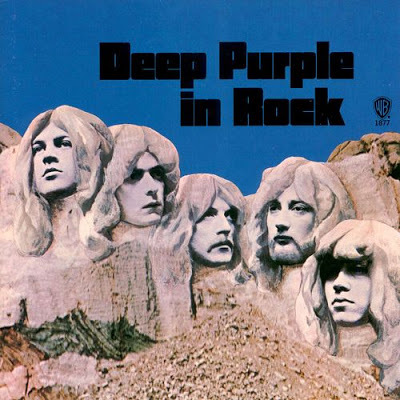 Deep Purple In Rock (AM7)Artist: Deep PurpleProducer: Deep PurpleLength: 43:30Released: June 3, 1970Tracks: 1) Speed King (5:52); 2) Bloodsucker (4:16); 3) Child in Time (10:18); 4) Flight of the Rat (7:53); 5) Into the Fire (3:30); 6) Living Wreck (4:31); 7) Hard Lovin´ Man (7:11)
Deep Purple In Rock (AM7)Artist: Deep PurpleProducer: Deep PurpleLength: 43:30Released: June 3, 1970Tracks: 1) Speed King (5:52); 2) Bloodsucker (4:16); 3) Child in Time (10:18); 4) Flight of the Rat (7:53); 5) Into the Fire (3:30); 6) Living Wreck (4:31); 7) Hard Lovin´ Man (7:11)Players: Ritchie Blackmore – guitar; Jon Lord – keyboards, organ; Ian Paice – drums, percussion; Ian Gillan – lead vocals; Roger Glover – bass
Often overlooked on the scene, despite several rounds of success, particularly in the U.K., Deep Purple began their long career as Roundabout. The idea, from former Searchers' drummer Chris Curtis, was to create a supergroup, centered on himself, in which other members would come and go, a process that would be key to the success of bands like King Crimson and later, Steely Dan. By 1968, the idea had flourished with a bevy of activity that included three studio LPs in the course of the year. Curtis would drift away, along with his idea, when Deep Purple, the band name adopted in 1968, signaled the demise of Roundabout. It was at that time that the band found pop success with the release of the top ten "Hush." DP fans refer to this line-up as Mark I, with the band taking a definitive pop stance.
Mark II was the band's most psychedelic venture, featuring core members Ritchie Blackmore, Ian Paice, and Jon Lord, though they still hadn't really found its voice (literally and figuratively). With the demise of their initial U.S. record label, Tetragramatton, the band was at a breaking point. It was then, and maybe due to the band's misfortune, that Blackmore and Lord approached Paice with the idea of taking on a heavier sound. Blackmore has said that the band wanted to be a Vanilla Fudge clone. Early in 1969, Blackmore recruited Ian Gillian as Deep Purple's frontman, along with bassist, Roger Glover. And then a break came in September 1969 with Lord's Concerto for Group and Orchestra, a three-movement piece the band played at the Royal Albert Hall. Alongside Days of Future Passed and The Nice's Five Bridges, it was instrumental (forgive the pun) in rock orchestration. The LP charted in Britain for Deep Purple's first real taste of success in their homeland.
Then, of course, came their watershed moment, Deep Purple In Rock. In singer Ian Gillan, the band had found a charismatic and powerful vocalist who could go the distance with Glover who brought his songwriting skills to form on songs like "Speed King," the epic "Child In Time" and the monumentally heavy "Into The Fire." It was this lineup that brought a sense of almost classical level musicianship and a relentless need for speed to hard rock – pretty good street cred.
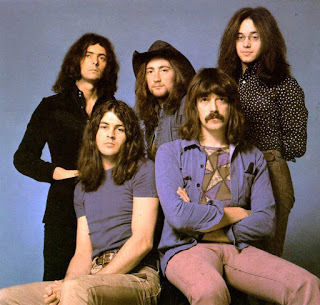 Recorded in October 1969 and released June 3, 1970, In Rock was recorded in three separate studios across London. Opening track, "Speed King," began life as "Kneel and Pray" having been in the live set for months before it was attempted in a studio setting. The initial idea had come from Glover and was based on a riff he had similar to "Fire" by Jimi Hendrix. Musically the interplay between Blackmore and Lord in the middle part of the song sets the standard for the next four or five years and Gillan's vocal shows off one of metal's greatest vocalists. "Bloodsucker" is a slower but even heavier track. Lord's brief organ solo giving the song the light it needs before Blackmore riffs the track out.
Recorded in October 1969 and released June 3, 1970, In Rock was recorded in three separate studios across London. Opening track, "Speed King," began life as "Kneel and Pray" having been in the live set for months before it was attempted in a studio setting. The initial idea had come from Glover and was based on a riff he had similar to "Fire" by Jimi Hendrix. Musically the interplay between Blackmore and Lord in the middle part of the song sets the standard for the next four or five years and Gillan's vocal shows off one of metal's greatest vocalists. "Bloodsucker" is a slower but even heavier track. Lord's brief organ solo giving the song the light it needs before Blackmore riffs the track out. "Child in Time" is, of course,e one the greatest studio recording of all time (and indeed, the Made in Japan version later on, is among the most iconic live performances). Gillan displays every vocal quality he has from the gentle delivery of the lyric to the unbelievable power of his screams. The solos and musical passages are sublime. I still get a chill every time Blackmore launches into his solo and then into the almost machine gun like frenzy that follows. Oddly, Ian Gillan has never been fond of the track and referred to his contribution as "yelling over a racket."
"Flight of the Rat" develops into another frenzied jam with a counterpoint vocal from Gillan with a gentler approach (one of the talents that would make his contribution to Jesus Christ Superstar the following year so stellar). The shortest track on the album, "Into The Fire" was in the live set with Ian Gillan introducing it as "rock and roll with its trousers down and back to front." While "Living Wreck" features some nice swirling organ from Lord and a slower solo from Blackmore, it is the LP's weakest track. "Hard lovin Man" was recorded January 1, 1970, so it's fitting that the track foreshadows the sound of the Deep Purple of the seventies. Another lengthy workout with lots of intricacies and solos for both Lord and Blackmore, it begins with what was to become a trademark Paice opening drum beat. The mayhem at the end of the track is a perfect ending to an album that heralded the arrival of heavy metal.
Published on June 06, 2020 04:54
June 3, 2020
Get your copy of Calif. by R.J. Stowell at Amaz...
Get your copy of Calif. by R.J. Stowell at Amazon or read it on your Kindle. And remember, Kindle Unlimited is FREE the first month. Thousands of titles from Harry Potter to Lord of the Rings - and Calif., of course! Here's the link. Help support your local writers.
Watch with sound, share and enjoy!
Signed copy? Contact me at rjsomeone@gmail.com - $15.00 - includes shipping.
Published on June 03, 2020 09:10
May 31, 2020
Today, concerts in and of themselves are money generating...
Today, concerts in and of themselves are money generating ventures. Tickets for concerts in the new millennium run hundreds of dollars, with special "meet and greet" events equaling the average paycheck, a pricing norm generated by Napster. Woodstock tickets, in comparison, were $18 for three days, and it wouldn't be unusual for a band to plan a high school tour in which tickets were three bucks. Concerts were a promotional concept with designs on getting attendees to purchase the LP or cassette. Because of this, every band toured for every LP.
When CSN emerged from out of Laurel Canyon in early 1969, particularly as what many consider the first "supergroup" (The Byrds, Buffalo Springfield, The Hollies), the trio knew it must tour. The issue on hand was the complexity of the music, arrangements that, in the pre-Unplugged days, were beyond the capacity of the live band, despite Stills’ virtuosity. It was Stills who spent 100s of Brian Wilson-like hours in the studio to make the debut what it is.
CSN was forced to vet out the gaps in their line-up. They needed a drummer, that went without saying, and chose session drummer Dallas Taylor, but Stills felt they needed another musician "proficient enough, but not as a composer or singer." The concept was to focus on the harmonies in the tour's initial songs and then venture into an electric set that rocked. Atlantic Records guru Ahmet Ertegun suggested Neil Young, Stills' partner in Buffalo Springfield, to fill the bill. It was Young who had, through his dominance brought about the demise of the Buffalo Springfield, particularly in a scheme to embark on a solo career, but Ertegun knew the dynamic that offset Stills and Young in the guitar protegees' electric duets.
By the time they "got to Woodstock," Crosby, Stills and Nash had been joined by Young, with Taylor and Greg Reeves, a teenaged bassist with Motown cred.
The CSN debut, by the time of Woodstock, had already spent time atop the Billboard 100 album chart and would continue in that vein for 107 weeks. Woodstock led to Déjà Vu's complexity. Stills and Ertegun understood that Stephen's hope for a rival who remained ghostlike behind the band wouldn't fly with Young, and luckily, it didn’t. Stills had no powerhouse follow-up to Suite: Judy Blue Eyes and out of that came a far more intensive eclecticism for the new LP.
Driving this, Stills' focus was "Carry On," which contained a rebooted arrangement for "Questions," edited out of the Buffalo Springfield's final album. Neil would counter with "Helpless," assimilating so perfectly into the CSN sound, and also with "Country Girl" and "Everybody I Love You." Not to be outdone, Crosby provided the title track and rock anthem, "Almost Cut My Hair," and Nash would contribute "Our House," "Teach Your Children," and, I'm sure, the emotional impetus for Joni Mitchell's "Woodstock."
Sometimes the magic isn't magical at all, think the agony of emotion behind Fleetwood Mac's Rumours, but the magic is there nonetheless, despite itself. Déjà Vu is one of those moments in music history when all the planets aligned; a perfect 10 on the AM scale.
Published on May 31, 2020 06:13
Crosby, Stills & Nash and Déjà Vu - 50 Years Ago
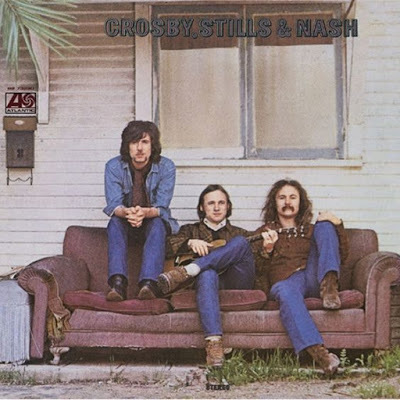 Crosby Stills and Nash (AM9): On one hand, it's exacting and rigorous - every aspect of the record compliments another in some holistic way. On the other, like a Monet, it's impressionistic - each song representing a shade, a sonic timbre that meshes and messes with each musical interpretation to present an erratic range of human emotions, effortlessly - "free and easy, the way it's supposed to be." "Suite: Judy Blue Eyes" stands unmatched in terms of expression. One can feel the helplessness in Still's voice when he pleads, "Can I tell it like it is, but listen to me baby- it's my heart that's a-suff'rin', it's a-dyin'." It's the foundation of "Helplessly Hoping," the most vocally moving piece, and comes to a climax on "49 Bye-Byes." Although it’s primarily a vocal LP, there is an incredible blend of musicianship and top-notch production.
Crosby Stills and Nash (AM9): On one hand, it's exacting and rigorous - every aspect of the record compliments another in some holistic way. On the other, like a Monet, it's impressionistic - each song representing a shade, a sonic timbre that meshes and messes with each musical interpretation to present an erratic range of human emotions, effortlessly - "free and easy, the way it's supposed to be." "Suite: Judy Blue Eyes" stands unmatched in terms of expression. One can feel the helplessness in Still's voice when he pleads, "Can I tell it like it is, but listen to me baby- it's my heart that's a-suff'rin', it's a-dyin'." It's the foundation of "Helplessly Hoping," the most vocally moving piece, and comes to a climax on "49 Bye-Byes." Although it’s primarily a vocal LP, there is an incredible blend of musicianship and top-notch production.Nash is Stills' lighthearted romantic equivalent. All of his tunes are delightfully simple but pure, a welcome break from Stills' intensity and Crosby's excess. "Marrakesh Express" and "Pre-Road Downs" are psychedelically tinged and "Lady of the Island" stirs up every desirous and wooing sentiment inside. It’s not that one of the triumvirate is more romantic than another. Instead it’s about how we each perceive romance in a different way.
Crosby's songs are more fanciful, the songs of a dreamer. Guinevere is about Joni Mitchell, but it's not; it's about Guinevere, it's about the ideal of womanhood through a man's eyes. It's old fashioned and whimsical. It's the folk rock/madrigal version of Burt Bacharach's "Wives and Lovers," as politically incorrect as the day is long, but a sentiment that harkens back to a simpler, more romantic time.
Ultimately, it doesn't matter who wrote what. What counts is that each artist shared a vision of earthiness, as evident as the LPs cover: three friends on an old coach.
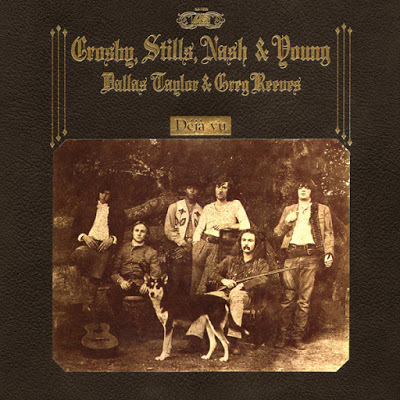 Déjà Vu (AM9): After the success of Crosby, Stills and Nash, the trio had to think about going on tour. To perform as a full electric band they needed, well, a band. In the end they chose to bring in Neil Young, who had played with Stills in Buffalo Springfield, and had recently started out on his own solo career. Now a quartet, they became Crosby, Stills, Nash & Young, with Dallas Taylor and Greg Reeves rounding out the players. Young's contract allowed him to continue with his solo career while he performed with the group, who went on tour in the summer of 1969 – and, of course, their second gig together was Woodstock.
Déjà Vu (AM9): After the success of Crosby, Stills and Nash, the trio had to think about going on tour. To perform as a full electric band they needed, well, a band. In the end they chose to bring in Neil Young, who had played with Stills in Buffalo Springfield, and had recently started out on his own solo career. Now a quartet, they became Crosby, Stills, Nash & Young, with Dallas Taylor and Greg Reeves rounding out the players. Young's contract allowed him to continue with his solo career while he performed with the group, who went on tour in the summer of 1969 – and, of course, their second gig together was Woodstock. With the addition of Young, Déjà Vu wasn't just part twoof the debut. The group broadened their palette, resulting in a more diverse collection of songs, if a less consistent effort because of it. More so than the first album it sounded like a collective of singer-songwriters rather than a band. Crosby and Nash's signature songwriting styles become more apparent, while Crosby contributes the solo hippie lament "Almost Cut My Hair" and the surreal, dream-like title track, whilst Nashcame up with the radio-friendly country-rock of "Teach Your Children" and the whimsical ode to domesticity of "Our House." Stills contributed the opener "Carry On", which defined the archetypal CSNY sound, and the quiet solo number "4+20," while Young wrote two songs, the slow, aching "Helpless" (which became one of his best-loved songs) and the three-part suite "Country Girl".
And yet, apart from his own songs, ol’ Neil doesn't sing anywhere else and adds guitar to just three others. He was always the outsider in the foursome and his presence on Déjà Vu is more as a guest guitarist who gets to sing his own songs; a bit closer to Taylor and Reeves than C, S & N, but this is picayune at best; Déjà Vu is one of the best LPs of the best era in rock, so it’s time for this critic to do what more critics ought to do, shut the hell up.
Published on May 31, 2020 05:19
May 28, 2020
Happy Anniversary to Us!
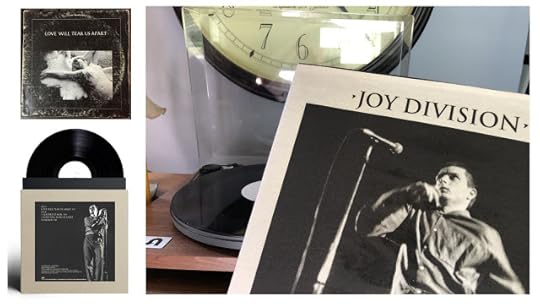 Today is the 6th anniversary of AM (amontheradio.com). In that time, we've logged more than 3 million hits. It was also nearly two years ago that I started the radio show, at first just five minutes, then big time on IHeart Radio, and now we do a 30-minute weekly thing, Friday mornings.
Today is the 6th anniversary of AM (amontheradio.com). In that time, we've logged more than 3 million hits. It was also nearly two years ago that I started the radio show, at first just five minutes, then big time on IHeart Radio, and now we do a 30-minute weekly thing, Friday mornings.While I consider myself pretty knowledgeable about the rock era from the 60s onward, and because I'm a collector, people seek my advice on the value of their records. But here's the thing: I'm a collector, not an investor. And while I do know plenty, I buy records, both new and vintage, for the music and my close association with vinyl as a medium. I don't buy what I buy based on its value as an investment. My White Album is mine. Discogs says that based on the low number and the pristine condition, it's worth well over $100 in average pricing. I only know that because of the point I'm making; I looked it up, but I don't care. I'm not selling.
And I have LPs worth far more. Still don't care. There is NEVER a time when I make a purchase and keep it sealed in its wrapper - that's for investors. I'm just here for the music and the aesthetics of having a collection of which I'm proud.
Don't get me wrong. I've sold items on eBay and Discogs, mostly when I've upgraded. Or, for instance, this "collectible," Joy Division's "Love Will Tear Us Apart" from Cleopatra Records that comes in a canvas bag. I've been playing it a lot because of the 40th anniversary of Ian's demise, but when I'm done, I'm selling it; it has no personal value. I'll get 40 bucks or so and with it, I'll upgrade my original copy, which is a mess, full of pops and gracklesquawks. I'll keep it because I've had it for 4 decades, then I'll get myself a replacement, mint, Factory Records (FAC23) - about $30. Win/win.
Bottom line: Your collection is worth what it means to you.
Published on May 28, 2020 07:12
The "Let It Be" Ghost Guitar - 50 Years Ago
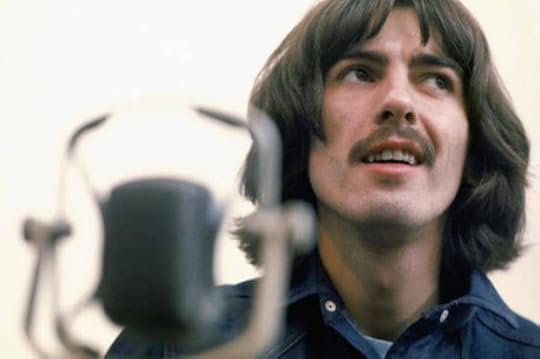 We tend to use the release date of an LP to guide us chronologically, yet with Abbey Road and Let It Be, that's simply not the case. Abbey Road, in particular, the Side 2 medley, was the last piece of music the Beatles ever worked on collectively. Let It Be would be released after the band broke up (and contributed to the breakup), but its problematic recording sessions came prior to Abbey Road. Because of Abbey Road's release date 50 years ago, Let It Be is often glossed over. That said, there's something I find so interesting about the recordings that made up the Let It Be sessions, one based on the associated issues in production: the ghost guitar on the title track.
We tend to use the release date of an LP to guide us chronologically, yet with Abbey Road and Let It Be, that's simply not the case. Abbey Road, in particular, the Side 2 medley, was the last piece of music the Beatles ever worked on collectively. Let It Be would be released after the band broke up (and contributed to the breakup), but its problematic recording sessions came prior to Abbey Road. Because of Abbey Road's release date 50 years ago, Let It Be is often glossed over. That said, there's something I find so interesting about the recordings that made up the Let It Be sessions, one based on the associated issues in production: the ghost guitar on the title track.There are two different versions of the song, "Let It Be." If you have the opportunity, listen to them both. The single version has a far more subtle guitar solo at the midpoint of the song (1:59), a loose string version that lends itself to the 45, and sounding as if an acoustic guitar had been electrified. The LP version, on the other hand, contains a more electrified solo. Listen to them back to back. But that there are two diverse versions of the song isn't the unusual part. What's odd is the ghost solo hidden beneath the layers of music that appears in both the single and the album versions. It's hard to hear unless you tune your ear to it, so it may be helpful to isolate the left side on the stereo version or to listen to the track by clicking your receiver to mono.
What was interesting and appealing about the project tentatively titled Get Back, meaning the Beatles getting back to the roots, is this noble idea of returning to the live sound that the Beatles had been famous for, starting with those Hamburg club dates. That in mind, the Beatles entered the studio on January 31, 1969, to record the track. "Let It Be," and by they, I mean all four of the Beatles, with Paul on piano, John Lennon oddly playing the bass, Harrison pm lead guitar, and Ringo on drums. Add to that, Billy Preston on the Hammond organ.
Ultimately, the single version of "Let It Be" was released March 6 and produced by George Martin. It would go to Number 1 on the Billboard Top 100. The album version was released in May 1970. On the back of the album, there's a phrase that states, "This a new-phase Beatles album;" the reality is, the Beatles had already broken up in April. just prior to the LP's release.
The album version of "Let It Be" had a headier, heavier guitar solo lushly, some would say overly-produced by Phil Spector; the George Martin version more typically Beatle-esque. Interestingly, both Spector and Martin left in the "ghost solo," an earlier take somehow left audible in the background of the masters which were subsequently released as the single and the album.
So, let's put the pieces together. On January 31, 1969, with the other Beatles, George recorded an original guitar solo, the ghost track that can be heard faintly but distinctly in the background. George was back in the studio alone on April 30, 1969, and recorded the solo that's on the 45. On January 4, 1970, George again took the master tape, recorded a year prior, and overdubbed what Phil Spector would use for the LP version. Here's something else; 30 years later, Paul McCartney produced an alternate version of the album called Let It Be Naked which eliminates the orchestral and heavy-handed production by Phil Spector on the original lp. For that version of "Let It Be," McCartney chose yet another solo from the January 1969 sessions. The ghost guitar? Still there.
Published on May 28, 2020 06:53
May 26, 2020
Joni's Screenplays
 With the 50th anniversary of Joni Mitchell's Ladies of the Canyon upon us, I've been listening to the album a lot when ordinarily I’d pass it by for Blue, Court and Spark or Hejira. It’s more an occasional listen. But listening through my headphones late at night, I got a greater sense of the LP and a better sense of Joni as a musician. She portrays a feather-like touch at the piano, but particularly with her off-tuned, loose stringed guitar. There is nothing quite like it on record. Here, as well, we get the first sense of Joni’s leaning toward the fusion jazz of subsequent LPs. It's the last real sense we get of Joni as a musician as well as a song stylist (place rebuttal here).But that's not what is so striking. Instead, the lyrics of the LP shine as mini screenplays. "Morning Morgantown" is setting the way Tennessee Williams wrote setting into his plays; like a storyboard for the day. And then the story comes to life with "For Free," a cinematic vignette just aching for adaptation. One is swept away as a character within the motif, in nearly every songscape; the listener is there with the songstress, walking down the canyon road (lovely, ideally), or with ennui. "You could have been more, than a name on the door, on the 33rd floor in the air," she sings on "The Arrangement." That air, of course, again reflected in the iconic "Woodstock," as she says more optimistically, "I have come here to lose the smog, and I feel myself a cog in something turning." (Those marvelous inner rhymes are what separate her poetry from merely the confessional.) One cannot help but tie those tracks together when, again in "The Arrangement," she writes with impossibly hopeful caution, "While you still have time, you could get away and find a better life." Who would have thought, just a few years before, that anyone in the utopia of mid-century America, would want to get away from it all, or could?This is the first of Joni's essential canon, from Ladies through Don Juan’s Reckless Daughter, that core of LPs that establishes Mitchell as the premier singer/songwriter of her era (or any other), and it hasn't, like a good screenplay, aged a bit over these 50 years.
With the 50th anniversary of Joni Mitchell's Ladies of the Canyon upon us, I've been listening to the album a lot when ordinarily I’d pass it by for Blue, Court and Spark or Hejira. It’s more an occasional listen. But listening through my headphones late at night, I got a greater sense of the LP and a better sense of Joni as a musician. She portrays a feather-like touch at the piano, but particularly with her off-tuned, loose stringed guitar. There is nothing quite like it on record. Here, as well, we get the first sense of Joni’s leaning toward the fusion jazz of subsequent LPs. It's the last real sense we get of Joni as a musician as well as a song stylist (place rebuttal here).But that's not what is so striking. Instead, the lyrics of the LP shine as mini screenplays. "Morning Morgantown" is setting the way Tennessee Williams wrote setting into his plays; like a storyboard for the day. And then the story comes to life with "For Free," a cinematic vignette just aching for adaptation. One is swept away as a character within the motif, in nearly every songscape; the listener is there with the songstress, walking down the canyon road (lovely, ideally), or with ennui. "You could have been more, than a name on the door, on the 33rd floor in the air," she sings on "The Arrangement." That air, of course, again reflected in the iconic "Woodstock," as she says more optimistically, "I have come here to lose the smog, and I feel myself a cog in something turning." (Those marvelous inner rhymes are what separate her poetry from merely the confessional.) One cannot help but tie those tracks together when, again in "The Arrangement," she writes with impossibly hopeful caution, "While you still have time, you could get away and find a better life." Who would have thought, just a few years before, that anyone in the utopia of mid-century America, would want to get away from it all, or could?This is the first of Joni's essential canon, from Ladies through Don Juan’s Reckless Daughter, that core of LPs that establishes Mitchell as the premier singer/songwriter of her era (or any other), and it hasn't, like a good screenplay, aged a bit over these 50 years.
Published on May 26, 2020 05:46
May 25, 2020
On Ladies of the Canyon
 In April 1970 Joni Mitchell released her third LP, Ladies Of The Canyon, an ode to the her neighbors and the Boho neighb of Laurel Canyon, a hillside paradise nestled in the purgatory of Los Angeles. Deep in a relationship with Graham Nash, the songs reflect her homely life. "Willy" and "Blue Boy" are profound, gentle love songs to Nash, while "Morning Morgantown" and "Ladies of the Canyon" offer sweet, romantic smalltown portraits. Some of the lyrics are a bit twee, and others are overly sweet or pretty, but why not; this is paradice; on the surface, anyway. Still there is an underrated power to this record. "For Free" is one of her strongest early songs, exploring the dichotomy between being a wealthy recorded artist and a modest street busker; it also features a dazzling clarinet solo at its climax, hinting at the jazz to come, though not as well as "The Arrangement." Here is one of Joni's first songs to explore jazz structures, if not jazz textures or arrangements. It is her most experimental and challenging song up to this point, and also perhaps the most difficult song to get into. "Rainy Night House" and "The Priest" are two highlights, gems tucked away, as if they were hidden in a rustic cul-de-sac.
In April 1970 Joni Mitchell released her third LP, Ladies Of The Canyon, an ode to the her neighbors and the Boho neighb of Laurel Canyon, a hillside paradise nestled in the purgatory of Los Angeles. Deep in a relationship with Graham Nash, the songs reflect her homely life. "Willy" and "Blue Boy" are profound, gentle love songs to Nash, while "Morning Morgantown" and "Ladies of the Canyon" offer sweet, romantic smalltown portraits. Some of the lyrics are a bit twee, and others are overly sweet or pretty, but why not; this is paradice; on the surface, anyway. Still there is an underrated power to this record. "For Free" is one of her strongest early songs, exploring the dichotomy between being a wealthy recorded artist and a modest street busker; it also features a dazzling clarinet solo at its climax, hinting at the jazz to come, though not as well as "The Arrangement." Here is one of Joni's first songs to explore jazz structures, if not jazz textures or arrangements. It is her most experimental and challenging song up to this point, and also perhaps the most difficult song to get into. "Rainy Night House" and "The Priest" are two highlights, gems tucked away, as if they were hidden in a rustic cul-de-sac. Mitchell's voice is very sweet and girlish here, which is odd considering that she showed a brassier tone on the earlier Clouds. It gives the album a pretty, romantic quality, and the hit "Big Yellow Taxi" is characteristic of the album's guitar-driven songs, which are few. Ladies of the Canyon instead features piano more prominently, a move Mitchell credited to to Laura Nyro, who was, at this time, a more sophisticated and developed artist. Overall, Ladies of the Canyon was an important step forward for Joni Mitchell, adding texture and substance to her previously modest, understated acoustic pieces.
 Laurel Canyon is a geographical oddity, a jumble of undeveloped Hollywood hills that butts up to West Hollywood. By 1968, the neighborhood had become the center of the local music scene. Nearly every Los Angeles musician lived there, jammed there, or crashed on somebody's couch there: The Byrds, The Mamas & the Papas, Crosby Stills Nash and sometimes Young, The Beach Boys, The Doors, Love, a few of the Monkees, Frank Zappa, The International Submarine Band, Jackson Browne, and scores more. "It was Brigadoon meets the Brill Building," wrote Michael Walker in his 2006 best-seller Laurel Canyon: The Inside Story Of Rock-and-Roll’s Legendary Neighborhood.
Laurel Canyon is a geographical oddity, a jumble of undeveloped Hollywood hills that butts up to West Hollywood. By 1968, the neighborhood had become the center of the local music scene. Nearly every Los Angeles musician lived there, jammed there, or crashed on somebody's couch there: The Byrds, The Mamas & the Papas, Crosby Stills Nash and sometimes Young, The Beach Boys, The Doors, Love, a few of the Monkees, Frank Zappa, The International Submarine Band, Jackson Browne, and scores more. "It was Brigadoon meets the Brill Building," wrote Michael Walker in his 2006 best-seller Laurel Canyon: The Inside Story Of Rock-and-Roll’s Legendary Neighborhood.The title track paints the area as a loose commune defined by the creative zeal and gregarious spirit of its inhabitants. It's tempting to read real-life counterparts into the three women Mitchell sings about. Is Trina really a stand-in for Szou Paulekas, who recycled vintage clothing into hippie-freak fashion and defined the look of a generation? Might Annie actually be Mama Cass Elliott, widely regarded as the Gertrude Stein of Laurel Canyon? Could Estrella be Joan Baez or Laura Nyro, or even Mitchell herself?
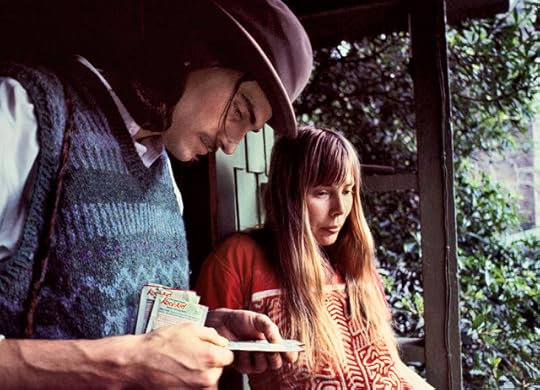
With its steep hills, winding dirt roads, and a handful of man made caves strung with lights, the canyon provided a woodsy refuge from L.A. Along with beautiful views of the city, it offered an escape from the social turmoil that defined the 1960s: the Watts riots in 1965, The Manson Family, the draft, the general sense of societal entropy – what Joan Didion in her essay "The White Album" called "the shifting phantasmagoria which is our actual experience." Ladies of the Canyon is a beautiful album, filled with yearning for the ideal world that was promised by so much of the music and culture of the '60s but by 1970 had been largely given up on (That was just a dream some of us had).
Published on May 25, 2020 17:48
May 23, 2020
Jackson Browne - Standin' at Der Weinerschnitzel - 50 Years Ago
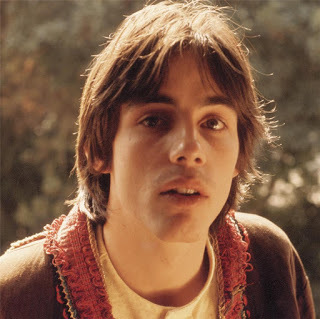 While Jackson Browne's formative years may have been those days in New York at The Dom, keep in mind that Browne was already an established singer/songwriter before he left high school; indeed, in his senior year, Jackson had joined The Nitty Gritty Dirt Band. Life in Orange County, California was a dream of surfboards, sunshine and fast cars, a veritable Beach Boys' song that Browne was living.
While Jackson Browne's formative years may have been those days in New York at The Dom, keep in mind that Browne was already an established singer/songwriter before he left high school; indeed, in his senior year, Jackson had joined The Nitty Gritty Dirt Band. Life in Orange County, California was a dream of surfboards, sunshine and fast cars, a veritable Beach Boys' song that Browne was living.Upon his return from New York, Jackson moved in with his mother in the L.A. suburb of Silverlake, but was soon to take another important sojourn. On a road trip with friends, Browne and his entourage went to Monterey Pop, the first superconcert of the era. We tend to focus on Hendrix, Janis and The Who when speaking of Monterey, but other headliners were equally impressive to the 18- year-old; among them Moby Grape, Laura Nero, Otis Redding, Simon and Garfunkel and Quicksilver Messenger Service. Of the concert, Mickey Dolenz of The Monkees, who would, along with Browne, become a fixture in the Laurel Canyon scene, said of the concert: "This was the beginning of the Summer of Love. There were love-ins, laugh-ins and in the middle of June, there was only one place to be: The Monterey Pop Festival." (There was one snag, though, despite the incredible music, Nico would attend the festival on the arm of Rolling Stone Brian Jones; emotionally upsetting to Browne. His "Birds of St. Marks" reflects the incident).
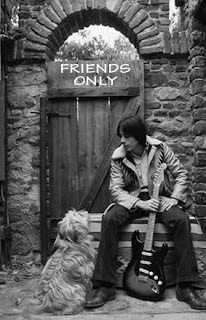
Following Monterey, Jackson returned to Silverlake. His good friend, Steve Copeland, lived nearby in Echo Park with girlfriend Pamela Pollard. Next door to Copeland was Glenn Frey, future Eagle, who at the time was in a duo with J.D. Souther, the Longbranch Pennywhistle. Another friend, Billy James, was instrumental in Jackson getting a demo deal with Elektra. That new entourage would prove a huge part of Browne's future in the Laurel Canyon set.
It was about this time that Jackson was adamant about recording his own songs, spurred on by the number of his songs released before the end of '67 by other artists, including several by The Nitty Gritty Dirt Band, those on Nico's solo and The Circle Game LP by Tom Rush, which included songs by three rising songwriters of the era, Joni Mitchell, James Taylor and Jackson Browne.
Jackson's most famous covered song was one he wrote in 1971 and recorded by The Eagles, "Take it Easy." Originally, the lyrics read "Standing on a corner in Flagstaff, Arizona." Browne started writing “Take It Easy” in the back of a Dodge panel van after his car broke down in Flagstaff and some new friends offered him a ride back to Los Angeles. It was there he saw a woman in a Toyota truck pulling out of what was then Der Wienerschnitzel at the corner of East Route 66 and North Switzer Canyon. The image stuck with him, although with the aid of friend and Eagle Frey, the name of the town was altered. Frey would also edit the line to read, "It's a girl, my Lord, in a flat bed Ford, slowing down to take a look at me," purportedly based on Jackson's statement that "Girls out there drive trucks!"
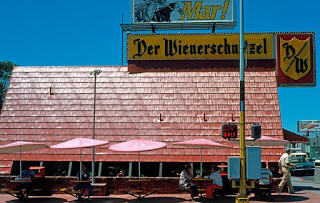 It's interesting to note the naivete in statements like that, and yet juxtapose the utter sophistication of a song like "These Days," written when Browne was just 16-years old. The song is drenched in regret: "These days I seem to think a lot, about the things that I forgot to do,/ I had a lover. I don't think I’d risk another, these days." The depth of remorse he manages is amazing, and only unwittingly funny if you let it be. He goes on to say, "Please don’t confront me with my failures/ I had not forgotten them;" a line so devastating we're not likely to forget it. It's an in-your-face line disregarding the tenets espoused by Stanislavsky, that one needs experience to experience; that one needs to live through tragedy in order to write about it, or to act it out. Browne's losses at 16 were more than likely limited to tennis matches, and yet we can all experience the angst apparent. Though not as celebrated as Joni or the newly forming Eagles, and despite his youth, Jackson Browne was the poet laureate of Silverlake.
It's interesting to note the naivete in statements like that, and yet juxtapose the utter sophistication of a song like "These Days," written when Browne was just 16-years old. The song is drenched in regret: "These days I seem to think a lot, about the things that I forgot to do,/ I had a lover. I don't think I’d risk another, these days." The depth of remorse he manages is amazing, and only unwittingly funny if you let it be. He goes on to say, "Please don’t confront me with my failures/ I had not forgotten them;" a line so devastating we're not likely to forget it. It's an in-your-face line disregarding the tenets espoused by Stanislavsky, that one needs experience to experience; that one needs to live through tragedy in order to write about it, or to act it out. Browne's losses at 16 were more than likely limited to tennis matches, and yet we can all experience the angst apparent. Though not as celebrated as Joni or the newly forming Eagles, and despite his youth, Jackson Browne was the poet laureate of Silverlake.
Published on May 23, 2020 06:18



